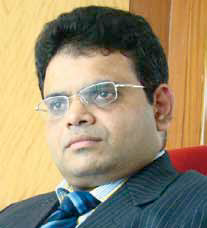
 In vitro diagnostics (IVD) has seen much technological advancements that have benefitted the end consumers
In vitro diagnostics (IVD) has seen much technological advancements that have benefitted the end consumers
By Sharmila Das, Elets News Network (ENN)
Indias diagnostic segment is so far dominated by unorganised local players. However, there are no doubts few organised players too like Roche Diagnostics, Abbott, Tulip Group, Transasia Biomedical, Span Diagnostics, etc are making their presence felt in this domain. As per the industry experts, the diagnostics market in India is witnessing a 20 percent growth which is faster than any country in the world. In the financial year 2011-12, revenue earned by the diagnostics sector is USD 600 million as against USD 510 million in 2010-11. The growth factors can be attributed to facts such as improved diagnostics tools, treatment monitoring, faster response times, and increased availability of over-the-counter (OTC) tests, which patients can perform in the comfort and convenience of their homes.

Market facts
The global IVD market is forecasted to grow at a Compoundeded Annual Growth Rate (CAGR) of 6.8 percent during 2011-18 to reach a value of ` 3, 61,500 crore (USD 72.3 billion) by 2018. The United States was the largest market for IVD and accounted for 50 percent of the global IVD market in 2011. The Asian region is expected to be ruled by the emerging economies such as China and India, showing the highest CAGR. China is the largest IVD market among emerging countries and Molecular diagnostics segment is gradually emerging as the fastest growing vertical in the diagnostics industry.
The pathology industry in India is around `10, 000 crore and about `1,000 crore is managed by organised sector comprising handful of top laboratories. The industry is highly competitive and price-driven with kickbacks and business referral payments in the absence of a regulatory body.
The sub categories
The Indian diagnostics market can be broadly divided into equipment and services segmemnts. The service sector is largely unorganised, with a large presence of players located at the regional or city level.
Backed by immense potential characteristics including a large population of qualified clinicians, huge number of patients, cost-efficient treatments, and a well-trained medical community, the lab services market, a leading segment of the Indian diagnostics market, is estimated to grow at a CAGR of around 26 percent during 201215.
John Thomas, Managing Director, Agappe shares, The current IVD market is shifting gradually towards semi-automated and fully-automated laboratory instrument. The number of tests conducted in the last decade has doubled to over 500 million tests. The major reason is the increase in awareness coupled with increasing middle class income which is leading to the increased IVD tests. Recent advances in the areas of molecularlevel and genetic testing are dramatically changing clinical practice. New testing techniques are more sensitive and specific and allow clinicians to detect, diagnose, and manage disease more effectively than ever before. Technologies that analyse DNA, RNA, and protein composition diagnose disease at initial level, permitting earlier detection and a more personalised approach to patient care.
Rajesh Pandya, Country Manager, Abbott Diagnostics, India feels, The market will exhibit steady growth in the future considering high patient population growth rate, increasing number of hospitals and diagnostic labs, innovation by pharmaceutical companies, unhealthy lifestyle leading to chronic diseases, demand for cost-effective, faster and sen-sitive results, increased affluence and
increased healthcare awareness.
Chinmoy Sinha, Cheif – Technomarketing Affairs, Diatek Healthcare & Sirus Biocare Pvt Ltd, says, Indian Diagnostic market is dominated mostly by the traders who import the product either in finished pack or as Original Equipment Manufacturer (OEM) and sell in their brand. Customers prefer better pricing of product and look for technologies which are time tested in advanced countries. So the majority of diagnostic company maintains mix up of product range to meet the customers demand of different sectors.
Expanding horizon
When around 70 percent of the treatment decisions in the country are based on lab results, Indian diagnostics players are too smartly putting their foot forward to meet the demand. They are too expanding their presence not only in India, but also in overseas territories like the Middle East and the United States. The spectrum of their test menu is expanding in the areas of genetics, cancer, endocrinology, infectious diseases, and molecular diagnostics. They are coming up with various business models to penetrate not only in tier-I, but also to tier-II and tier-III cities. The organised segment can explore the opportunities of expanding to semi-urban and rural areas and here mergers and acquisitions would likely be a route for expansion.


John Thomas
Managing Director,
Agappe
The current IVD market is shifting gradually towards semiautomated and fullyautomated laboratory instrument. The number of tests conducted in the last decade has doubled to over 500 million tests
Local/Organised
Research study says multinationals have a larger share of the diagnostics market pie because they have products which cut across all segments whereas local companies choose to focus only on one segment. However, this trend is seeing a change now as several local manufacturers are now adding new capabilities and technologies to match global standards. The key growth products include hematology, reagents, molecular diagnostics, and specialty diagnostics. Molecular diagnostics contributed 30-40 percent of the total market.
Inside the sector
In India, technological advancements and higher efficiency systems are taking the market to new heights. Use of advanced and cutting-edge technologies in understanding a disease prognosis has further strengthened the sophistication level of participants in the sector.
Rapidly rising automation needs along with the rising incidence of diseases are consistently driving the growth of the Indian diagnostics market. The increasing number and complexity of tests, coupled with a shortage in laboratory staff, is leading to a greater level of automation in laboratories. Labour accounts for around 65 percent of operating expenses in a typical laboratory, and automating a laboratory can expand its capabilities while achieving significant savings.
Dr Suresh Kuruganti, Consultant, Public Health, International Centre for Advancement of Rural Eye Care (ICARE), L V Prasad Eye Institute says, The potential of IVD in healthcare is immense and its role cannot be over emphasised considering the volume and magnitude of clinical load, the increasing awareness and knowledge of different conditions, and exponential growth in demand for care that is taking place. Many of them are cost-effective and can be replicated easily. All developing countries stand to benefit in general. These developments have brought about many improvements in the healthcare scenario, and have better acceptability.
Rural connect
There is also tremendous growth potential in tier-II and tier-III cities. India is the home to over 100 cities with enough population size to generate demands for diagnostics centres catering to a wide range of requirements. Several healthcare giants are seeking to tap into this market. Lifestyle and communicable diseases are no longer restricted to urban centres and are spreading to rural areas as well. As a large portion of rural areas do not have even the basic healthcare facilities, several cases remain undiagnosed. These changing disease patterns, rising incidence of diseases, higher healthcare spending, and untapped markets create abundant opportunities for IVD manufacturers in rural and semi-urban areas. Dr B R Das, President- Research & Innovation, Mentor – Molecular Pathology & Clinical Research Services, SRL Limited says, Over the past decade, patient awareness has increased several fold. Most people in tier-I and tier-II cities are aware of the benefits of frequent check-ups and preventive healthcare, and this has also percolated down even to tier-III cities and rural areas. Moreover as urbanisation has created an erratic lifestyle and shifting demographics, healthcare is on top of everyones list. So all this has greatly contributed to individual opting for such diagnostics.

Rajesh Pandya
Country Manager,
Abbott Diagnostics,
India
The market will exhibit steady growth in the future considering high patient population growth rate, increasing number of hospitals and diagnostic labs, innovation by pharmaceutical companies
Regulations and IVD
Despite the prime significance of this sector, a well-defined regulatory pathway for diagnostics products is awaited. Due to lack of regulatory legislation, there is no clarity on the classification and requirements for approval of diagnostics products and novel medical devices in India.
An insider from the industry who requests anonymity, shares There is need for a change in the way approvals to such products are given by the Drug Controller General of India (DCGI). At the time of approval, diagnostics products and medical devices are categorised into critical and non-critical diagnostics. Any diagnostics tool developed by an indigenous company or academic institution has to go through a validation process conducted by an independent DCGI-approved test ing lab such as National Institute of Biologicals (NIB), apart from in-house validation procedures conducted by the company itself. For other products, it needs to be proven that there are same products approved in India. Despite huge technological differences between the two, diagnostics are still treated as drugs by the DCGI.
Currently, the DCGI recognises primarily HIV, Hepatitis B and C blood grouping, and Syphilis kits as these need serious licensing and regulations. Regarding the rest of kits, there are neither guidelines nor any institutes, with known positives and negatives to be tested. This leads to Indian companies innovating new diagnostics to face a great difficulty in catering to overseas market opportunities as the country of origin has no properly laid-out procedures.

Dr Suresh Kuruganti
Consultant,
L V Prasad Eye Institute
The potential of IVD in healthcare is immense and its role cannot be over emphasised considering the volume and magnitude of clinical load
In contrast, products, which are im-ported and marketed into the country, do not have to go through these procedures as they have been approved by globally accepted regulatory standards. Owing to Indias diverse population, validation becomes a prerequisite for all companies as the product might be effective on one section of the population while it may not be effective on the other. There is a need for the Government to establish a clear pathway for such uation processes
Lack of clear specifications also allows for many products, which are not classified by the DCGI, to get into the market without any approval. At times, new products cannot be introduced in the market as they do not fit in any regulatory classification. Lack of such regulatory frameworks and standards in India brings a large disparity on the quality of products. Many products are available in India without approval. This puts pressure on the buyer to first test
the product in-house before using it on patients. In turn, the buyer expects free
samples from the seller, which delays the sales cycles and increases costs. The Association of Diagnostic Manufacturers of India (ADMI), an association of Indian IVD manufacturers, has approached the Government with various proposals for reforms.
Roadblocks
The Indian IVD industry is highly fragmented due to low-entry barriers, which has led to an increase in the number of laboratories, and the complete lack of standardisation. Another significant concern for companies is the inadequate insurance coverage. Responding to the demand for quality healthcare, most corporate labs have introduced cost-effective and convenient patient care packages.
The cost of equipment contributes to almost 40 percent of the cost in a tertiary
setup. The diagnostics equipment are cutting edge at the time of purchase; there is the threat of inevitable obsolescence within five to seven years of the setup. Most of such equipment are imported and very few local reputed manufacturers exist. This leads to apportioning to higher treatment costs and lesser competitive edges and low utilisation rates resulting in undesired operating margins.
Pandya says, The diagnostics market in India is highly fragmented and some of the challenges to the market include prence of laboratories without accreditation, quality control, low penetration of insurance, Rupee depreciation and low priced reagent sales. Abbott introduces significant technological advancements enabling creation of modern and progressive diagnostics laboratories that help diagnose and monitor diseases such as AIDS, Hepatitis, Cancer, Heart ailments, metabolic disorders and important indicators of general health, improving patient care diagnostics.
Early detection poses a new opportunity

Chinmoy Sinha
Cheif – Technomarketing Affairs,
Diatek Healthcare & Sirus Biocare Pvt Ltd
Indian Diagnostic market is dominated mostly by the traders who import the product either in finished pack or as Original Equipment Manufacturer (OEM) and sell in their brand
Screening technology for early detection of major cancers has not been within the reach of the IVD sector until now – with the exception of the prostate-specific antigen (PSA) test for prostate cancer. However, for most cancers, early detection and treatment can provide significant improvement in survival prospects when compared with late detection and treatment. A noninvasive IVD-based test that would allow detection of a major cancer, with high accuracy and at an early stage, would be attractive, considering many issues with current, mainly in-vivo-based procedures.
A wave of new IVD-based tests has started to reach the market and could offer new hope for early detection of major cancers. If the IVD-based models were validated, drug-like blockbuster revenues could follow some tests. The commercial payback for one such test could surpass the revenues of a companion diagnostics by a multiple of 10.
The IVD originators in this market segment will need large commercial partners to help them exploit the opportunity. Major IVD players or clinical laboratories would be the obvious candidates. By 2020, several pharma players are expected to become involved as well, provided clinicians and payers have validated the most promising tests within the next few years.
End note
ICT automates the entire process of testing, starting from the online patient booking to the registration of the sample and then finally getting the report digitally signed after analysis of the sample. ICT is expected to play an important role in data mining in pathology and diagnostics industries, which are growing leaps and bounds. Private companies are striving to increase health awareness among the common man, not only in metro cities but also in tier-II, tier-III, and smaller towns.
Delivering the right data in a timely and cost-effective manner while improving the sensitivity and specificity of the test is the need of the hour and the industry needs to gear up for single workstations that can carry multiple workloads.
Be a part of Elets Collaborative Initiatives. Join Us for Upcoming Events and explore business opportunities. Like us on Facebook , connect with us on LinkedIn and follow us on Twitter , Instagram.










